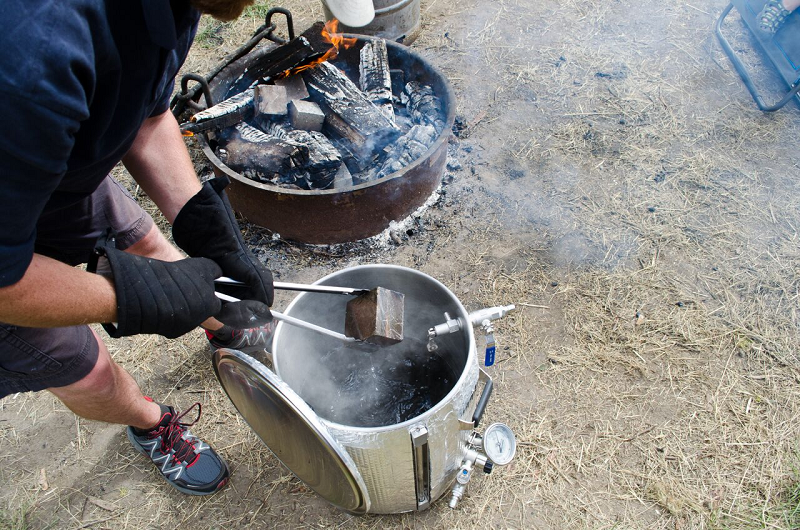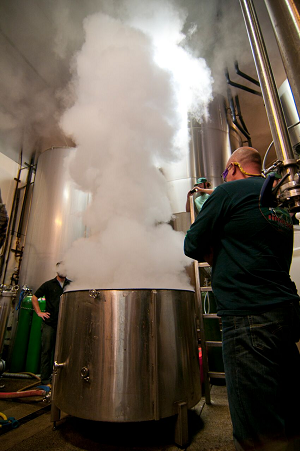Homebrewing with Hot Stones: How to Brew a Steinbier
Last summer, I joined my local homebrew club, Bridger Brew Crew, on our annual camping trip. A mountain stream, clear weather, the backdrop of Montana’s Absaroka Range and the company of fellow homebrewers set the scene for the weekend. In that interim, I also became better acquainted with an ancient and loosely defined beer type known as a steinbier.
Steinbier, which means “stone beer” in German, refers to a brewing process dating back to the Middle Ages, wrote Fred Eckhardt in a March 2001 column for All About Beer. The method, he explains, involves adding superheated stones to beer wort to effect mash conversion temperatures. The type of stones chosen usually consist of sandstone or granite because of their ability to store and radiate heat well, as well as to not explode during the warming process.
Eckhardt goes on to describe modern stone brewing’s resurrection on a commercial scale in its homeland of Germany in 1982 by Gerd Borges of Rauchenfels Brewery in Neustadt, Bavaria. Nearly a decade later in 1993, steinbier made its debut in the United States when Boscos Restaurant & Brewing founder Chuck Skypeck released the first iteration of what would later become the brewery’s signature Flaming Stone Beer. According to the brewery’s website, the stone-brewed Oktoberfest-style lager soon became a tap staple for the Memphis, Tennessee, brewery, making Boscos the first North American brewery to regularly make a stone beer.
Both breweries’ steinbiers were created using, for the most part, modern methods, including an exact-temperature-controlled mash. Hot stones were incorporated either at the beginning of the wort boil, as in Boscos case, or at the very end, as Rauchenfels did.
Jason Henkle, homebrewer and steinbier recipe designer of Bridger Brew Crew’s steinbier experiment, recalls tasting Boscos Flaming Stone Beer for the first time during a visit to Boscos now-closed Nashville location in the late ’90s.
“The predominant character of the beer was a caramelized flavor from the superheated stones scorching the sugars in the wort,” Henkle says.
Using this memory as his baseline and staying true to homebrewers’ exploratory nature, Henkle crafted a malt-forward beer recipe for a gruit, modeled after the grain bill of an English brown, for the homebrewed steinbier.
Much like the steinbier process, gruits also have medieval origins predating the use of hops in brewing, which began somewhere around the 11th century. Contrasting to hopped beers, gruits use a combination of herbs such as bog myrtle, mugwort, yarrow and sweet gale to bitter and preserve beer.

Members of the Bridger Brew Crew used hot stones to brew a “steingruit.” (Photo by Jesse Bussard)
Henkle and his fellow homebrewers used hot stones, consisting of soapstone, as the primary and only heat source throughout the entire brewing process for their “steingruit.” The soapstone, also known for its heat-holding properties, was sourced by another homebrew club member from leftover masonry supplies at a local construction site. Four to five fist-sized, cube-shaped rocks—which were heated on a campfire—brought the cold, filtered creek water to strike temperatures (around 163 degrees F) in five minutes. After a standard single-infusion mash and sparging, hot stones were again used to heat the wort to boiling. A stone was added about every 10 minutes to maintain the boil for an hour.

Members of the Bridger Brew Crew used a natural mountain stream as a wort chiller. (Photo by Jesse Bussard)
After the boil, the brewers took advantage of a nearby mountain stream, using it as a natural wort chiller to cool the wort from boiling to yeast-pitching temperature. The cooling took an impressively short five minutes.
All in all, Henkle describes the final product, named Smoke Gets in Your Eyes, as an easy-drinking, medium-bodied, well-balanced beer with herbal and caramel notes. Despite the name, there was no smoke present, and no ash or stone fragments made their way into the fermenter, making for a very clear beer.

For Port Brewing Co.’s Hot Rocks Lager, rocks were heated over a propane burner for about two hours, reaching a temperature of 800 degrees F. (Photo courtesy Port Brewing Co.)
While still a rarity in today’s beer scene, for the most part, commercially available steinbiers tend to be lagers. Breweries like Port Brewing Co., of San Marcos, California, see the brewing method as a way to meld New World beer styles with Old World processes.
Port Brewing’s co-founder and director of brewery operations, Tomme Arthur, explains he used four kegs with holes cut into the bottom and top to hold the granite stones used during the brewing process. The rocks were heated over a propane burner for about two hours, reaching a temperature of nearly 800 degrees F. The kegs containing the superheated stones were then lowered into an open-top brew kettle via a forklift at the end of the boil to take advantage of the caramelization that occurs from the wort running over the hot rocks.
“It’s not the easiest beer to produce,” says Arthur, “but it’s one that ultimately is a great vehicle and storytelling starter.”
Hot Rocks Lager has been available in bottles in the past but is currently out of production. Port Brewing brought the seasonally brewed lager back as a spring draft-only release at the brewery this year.
Steel & Oak Brewing Co. of New Westminster, British Columbia, produced a collaboration steinbier with Germany’s Freigeist Bierkultur in the summer of 2016. The brewery, which is in a suburb of Vancouver, has seen tremendous growth since opening its doors in June of 2014.
When it came to the style for Steel & Oak’s steinbier, head brewer Eric Moutal also went with a lager. His brew process was similar to Port Brewing’s, using kegs as colanders to hold the hot granite stones. With the help of a forklift, the stones were lowered into the kettle to immerse them in wort. In a departure from Port Brewing, Steel & Oak introduced stones into the wort on not just one, but two occasions—once during the lauter and again during the boil. Wort was pumped into a separate kettle for the process and run over the hot rocks.
“As soon as the wort hit the rocks, it started sizzling! It was like a steam bath,” Moutal says. “It smelled amazing, and you could just pick up the aroma of the caramelization happening!”

For Steel & Oak Brewing Co.’s steinbier, brewers introduced hot stones into the kettle on two occasions. (Photo courtesy Steel & Oak Brewing Co.)
Like many breweries, Steel & Oak Brewing has its flagship beers, Moutal says. But, due to the rave reviews received for its steinbier and the quick sellout of the bottled and draft beer after its release, he expects the style will be back on tap in the tasting room soon.
“People are asking us to brew it again,” Moutal says. “So we may start doing it once a year in small batches.”
Recipe
“Smoke Gets in Your Eyes” Stein Gruit
(5 gallons, all-grain)
Ingredients:
6 pounds American two-row malt
5 pounds Munich malt
1 pound Caramel / Crystal 120L malt
8 ounces Caramel / Crystal 60L malt
4 ounces CaraPils / Dextrine Malt
1.5 ounces Bog Myrtle
1.5 ounces Rosemary
1.5 ounces Yarrow
1 teaspoon Irish Moss
Starter of Wyeast English
Special Bitter yeast (WY1768)
Instructions:
1. Start a hardwood fire in a fire ring or large grill. Spread the hot coals out to form a bed at least 1-inch deep. Initially, place rocks (preferably sandstone or granite) in the coals for approximately an hour to heat. Depending on preference, stones may be used as primary heat source for the entire brewing process or a propane burner can be used to speed the process along.
2. Mash grains in 4.25 gallons of water in a single infusion mash at 152 degrees F for 60 minutes. Sparge with 170 degree water to collect 7 gallons. (Note: Using a kettle slightly larger than the desired amount of beer to be brewed is highly suggested as rocks will cause displacement of the wort. In this case, a 15.5 gallon keggle (keg converted into a kettle) was used.)
3. When all the wort is collected in the boiling vessel, remove 3-5 superheated rocks from the fire. Use heat-resistant metal tongs to pick rocks out of the embers and place in wort. If desired, a stainless-steel colander can be used to hold rocks and submerge them in the wort or rocks can simply be placed directly into the wort. Repeat this process for the entire boiling period, adding a stone about every 10 minutes to maintain the boil. (Note: The same procedure can also be used to heat water for the mash and sparge steps.)
4. Thirty minutes into boil, add gruit herbs. Total boil is 60 minutes. Chill to 65 degrees using wort chiller or mountain stream if one is nearby and pitch one-quart starter of yeast. Ferment at 70 degrees for approximately 10 days. When krausen drops back, check specific gravity. Rack into secondary (on top of “caramelized” stones if desired) when gravity hits 1.017. Age at cellar temperatures (or lower) for three to five days. Bottle and prime. Condition in bottle for 14 to 21 days.
OG = 1.061 FG = 1.017
IBUs = unknown due to absence of hops

Leave a Reply